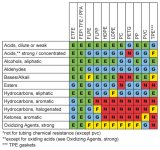I see an increasing trend in people utilizing resins/plastics for use in thier extractions verses using glass. The upsides to this can be seen immediately, they are lighter, stronger, more resiliant to damage than glass, but they also have their downsides. Certain plastics are susceptable to damage using hydrocarbon solvents, so I did some searching and found this nice little cheat-sheet as to which plastics are safe for use with your solvent.
Green: 30 Days of constant exposure causes no damage. Plastic may tolerate for years.
Blue: Little or no damage after 30 days of constant exposure to the reagent.
Yellow: Some effect after 7 days of constant exposure to the reagent. The effect may be crazing, cracking, loss of strength or discoloration.
Red: Not recommended for continuous use. Immediate damage may occur. Depending on the plastic, the effect may be severe crazing, cracking, loss of strength, discoloration, deformation, dissolution or permeation loss.
For reference, I sourced this chart and the color codes from Chemical Compatibility Chart - LDPE, HDPE, PP, Teflon Resistance
Green: 30 Days of constant exposure causes no damage. Plastic may tolerate for years.
Blue: Little or no damage after 30 days of constant exposure to the reagent.
Yellow: Some effect after 7 days of constant exposure to the reagent. The effect may be crazing, cracking, loss of strength or discoloration.
Red: Not recommended for continuous use. Immediate damage may occur. Depending on the plastic, the effect may be severe crazing, cracking, loss of strength, discoloration, deformation, dissolution or permeation loss.
For reference, I sourced this chart and the color codes from Chemical Compatibility Chart - LDPE, HDPE, PP, Teflon Resistance

